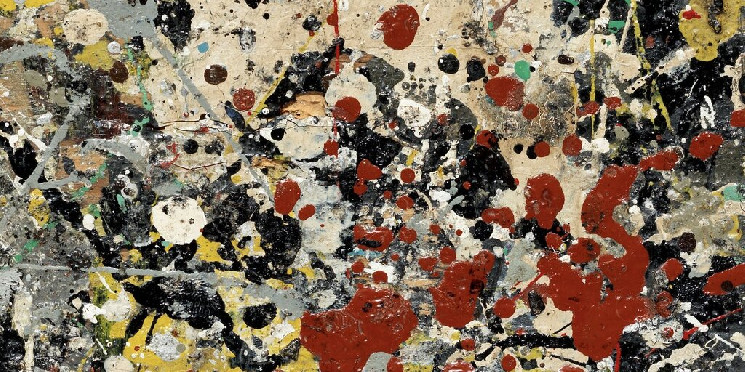An art collection released on Wednesday that includes both NFTs and physical prints immortalizes the paint-splattered floor of Jackson Pollock’s studio, translating elements of the artist’s distinct style to tokens on the Ethereum network.
Released by the Jackson Pollock Studio in collaboration with digital art platform Iconic Moments, “Beyond the Edge” showcases paint splatters that landed next to Pollock’s masterpieces like “Convergence” and “Blue Poles” in East Hampton, New York.
A famed American painter, the late Pollock’s work is synonymous with the art world’s abstract expressionist movement. Proceeds from the collection’s sale will help the museum maintain one of its most precious assets, studio director Helen Harrison told Decrypt.
Here’s a sneak peek of an edge!#BeyondTheEdge prints are on Hahnemuhle museum etching paper with hand-torn edges. We worked closely with Laumont Studio and our art advisors to get the paper selection and texture correct to make these a showcase piece for any collector. pic.twitter.com/iQWPskvM7j
— Iconic (@Iconic_NFT) July 19, 2023
“The primary initiative is preservation and interpretation of the floor,” she said. “It’s a wooden building, and it’s vulnerable—to termites, rain, and just wear and tear.”
The collection’s first series comprises 500 NFTs that capture four unique perspectives of the studio floor. Each NFT is accompanied by a physical print, embossed and numbered by hand at the Jackson Pollock Studio.
The series is available for people to mint on Wednesday for 0.8 ETH (about $1,525), but it’s initially limited to those within Iconic Moments' membership community and collectors of other partnered NFT projects, CEO Chris Cummings told Decrypt.
Following the initial sale launch, art collectors will also have the chance to purchase items using a credit card. Cummings said it was essential to cater the collection’s release to both “digital savvy collectors” and more traditional ones.
The paint-splattered floor of Pollock’s studio was uncovered in the late 1980s after his workspace was turned into a museum. The building—originally used as a storage barn to house fishing equipment—was first renovated in 1953, preserving the paint and floor under a layer of hardboard, Harrison said.
The floors’ famed colors have been licensed before, she added. For example, the pattern graced a limited-edition pair of Crocs first introduced in 2013. However, the images captured for the NFTs and prints are distinct for their fidelity, Harrison said.
“The level of intensity with which you can scrutinize it is just beyond anything,” she said, adding it's possible to view individual hairs embedded in the paint.
In August, the collection will expand to include a set of Pollock Ordinals inscriptions, leveraging the buzzy Bitcoin protocol to further preserve aspects of Pollock’s legacy through several 1-of-1 (or single edition) digital art pieces.
Collaborations with three digital artists are also in the works to produce “Art From Art,” which will include homages to and renditions of Pollock’s work. The first artist will be the pseudonymous Lucréce, whose work has sold at preeminent auction houses including Christie’s and Sotheby’s.
What if I told you I’m going to be working with the legendary Jackson Pollock studio through the Iconic team to make something unreal? 🧿 https://t.co/Dos7n8UGFP
— Lucréce (@DesLucrece) July 16, 2023
While Pollock could be considered a traditional artist by today’s standards, his artwork turned heads in the mid-20th century. A colorful mix of kinetics and emotion conveyed with broad gestures instead of meticulous brush strokes caused some people to question his artistry, Harrison said.
She described Pollock’s boundary-pushing methods as akin to digital artists who use cutting-edge technology today, despite some pushback to NFTs.
“Each age finds its own technique,” Harrison said, reprising a quote from Pollock. “If he were with us today, he would probably be doing digital art, because that was the kind of innovation that appealed to him.”
Cummings said that Pollock’s work has played an influential role in shaping the generative art scene that looms large in the NFT art world. He said several digital artists have referenced Pollock as their main inspiration, and—in some sense—Pollock was an early pioneer.
“[Pollock] knew what color he was choosing and whether he was going to throw or drip the paint, but there was a randomness involved,” he said. “In generative art, you’re writing an algorithm, setting some parameters, but you do not know what those outputs are going to look like.”
 decrypt.co
decrypt.co
